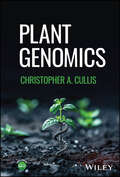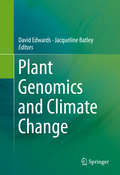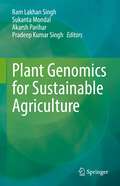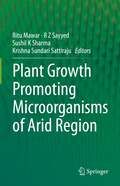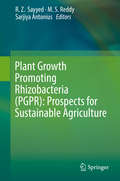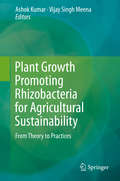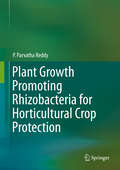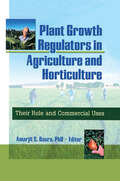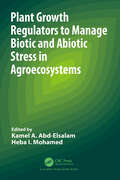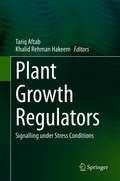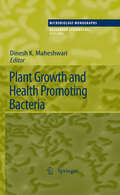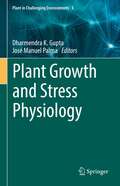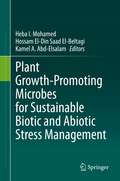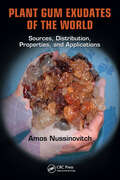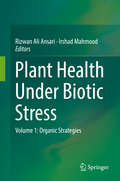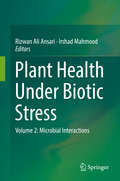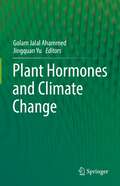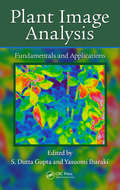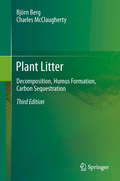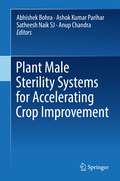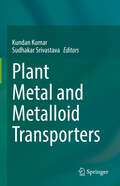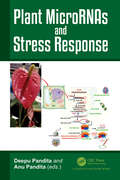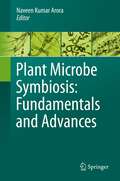- Table View
- List View
Plant Genomics
by Christopher A. CullisIntroduction to the range of molecular techniques to investigate unique facets of plant growth, development, and responses to the environment Plant Genomics introduces the complex relationship between the genome, microbiome, genes, and epigenetics of plants, as well as the range of molecular techniques applicable to investigating the unique facets of plant growth, development, and response to the environment. State-of-the-art science in the field is discussed, as well as future outlooks on what the next decade is likely to bring. This book includes new techniques for modifying the plant genome and their impact on modifying plants to combat the impact of biotic and abiotic stresses, including those associated with climate change, new technologies including long and short read sequencing and proximity ligation and the combination of these technologies for assembling sequence data into chromosomes, a new chapter on the sequences of the chloroplast and mitochondrial genomes, and a dedicated chapter to epigenetics and the importance in gene regulation. Written by a highly qualified author with significant published research contributions to the field, Plant Genomics includes information on: Structure and information content of the chloroplast and mitochondrial genomes and their use in phylogenyUse of transcriptomes from various tissues to identify expressed sequences and their identification as genesFunction of small regulatory RNAs and long non-coding RNAs and involvement of small RNAs in the control of gene expressionEpigenetic silencing of transposable elements and their release by stress and cross-generational contribution of epigenetic variation Use of the pan-genome to assemble a comprehensive germplasm for a particular crop species Plant Genomics is an ideal textbook for undergraduate courses on plant biology, particularly those focusing on molecular descriptions, and a helpful auxiliary text to plant biology laboratory courses. It will also be of interest to students in plant molecular biology, agricultural and food sciences, and plant, food, and crop bioengineering.
Plant Genomics and Climate Change
by David Edwards Jacqueline BatleyThis book explores the impact of climate change on agriculture and our future ability to produce the crops which are the foundation of the human diet. Specifically, individual chapters explore the potential for genomics assisted breeding of improved crops with greater yield and tolerance to the stresses associated with predicted climate change scenarios. Given the clear and unmet challenge to mitigate climate changing events, this book will be of wide interest from plant breeders and environmental scientists, government bodies through to a more general audience who are interested in the likely impact of climate change on agriculture.
Plant Genomics for Sustainable Agriculture
by Ram Lakhan Singh Pradeep Kumar Singh Sukanta Mondal Akarsh PariharThis book collates the basic and advanced concepts of plant biotechnology and genomics along with the future trends. It discusses the combination of conventional breeding techniques with genomic tools and approaches leading to a new genomics-based plant breeding technology supporting crop plants that respond better to biotic and abiotic stress, and pathogen attacks. Plant genomics play an important role in developing more efficient plant cultivars which are essential for the neo green revolution needed to feed the world’s rapidly growing population. Plant genomic data is being utilized in genetic engineering to ensure that better and resilient varieties of crops are available ensuring food security. This book is of immense interest to teachers, researchers, crop scientists, capacity builders, and policy makers. Also, the book serves as additional reading material for undergraduate and graduate students of agriculture, biotechnology, genomics, soil science, and environmental sciences. National and International agricultural scientists and policy makers will also find this to be a useful read.
Plant Growth Promoting Actinobacteria
by Gopalakrishnan Subramaniam Sathya Arumugam Vijayabharathi RajendranGlobal yields of legumes have been relativelystagnant for the last five decades, despite the adoption of conventional andmolecular breeding approaches. The use of plant growth-promoting (PGP) bacteriafor improving agricultural production, soil and plant health has become one ofthe most attractive strategies for developing sustainable agriculture. Actinomycetes arebacteria that play an important role in PGP and plant protection, producesecondary metabolites of commercial interest, and their use is well documented inwheat, rice, beans, chickpeas and peas. In order to promote legumes, the general assembly ofthe UN recently declared 2016 the "International Year of Pulses. " In view ofthis development, this book illustrates how PGP actinomycetes can improve grainyield and soil fertility, improve control of insect pests and phytopathogens,and enhance host-plant resistance. It also addresses special topics of currentinterest, e. g. the role of PGP actinomycetes in the biofortification of legumeseeds and bioremediation of heavy metals.
Plant Growth Promoting Microorganisms of Arid Region
by Ritu Mawar R Z Sayyed Sushil K Sharma Krishna Sundari SattirajuThis edited book aims to focus on microbial diversity in arid lands and deserts versus specific microbial assemblages associated with plants. The book explains ecological drivers that shape this diversity, how plant-associated microbiomes are selected, and their biotechnological potential are discussed. Diversity and functional redundancy of these associated PGPM make them very active in supporting plant improvement, health and resistance to drought, salt and other stresses, and these dimensions will be explored in this book. Implementing proper biotechnological applications of the arid and desert-adapted PGPM constitutes a sizeable challenge, and the book attempts to take up that challenge and help researchers in this field to gain a detailed understanding of PGPM from arid ecosystems. This book serves as a handbook for research workers, teachers, postgraduate students and extension personnel, other development workers, and policy planners engaged in arid zone development.
Plant Growth Promoting Rhizobacteria (PGPR): Prospects for Sustainable Agriculture
by M. S. Reddy R. Z. Sayyed Sarjiya AntoniusSustainable increase in agricultural production while keeping the environmental quality, agro-ecosystem function and biodiversity is a real challenge in current agricultural practices. Application of PGPR can help in meeting the expected demand for increasing agricultural productivity to feed the world’s booming population. Global concern over the demerits of chemicals in agriculture has diverted the attention of researchers towards sustainable agriculture by utilizing the potential of Plant Growth Promoting Rhizobacteria (PGPR). Use of PGPR as biofertilizers, biopesticides, soil, and plant health managers has gained considerable agricultural and commercial significance. The book Plant Growth Promoting Rhizobacteria (PGPR): Prospects for Sustainable Agriculture has contributions in the form of book chapter from 25 eminent global researchers, that discusses about the PGPRs and their role in growth promotion of various crop plants, suppression of wide range of phytopathogens, their formulation, effect of various factors on growth and performance of PGPR, assessment of diversity of PGPR through microsatellites and role of PGPR in mitigating biotic and abiotic stress.This book will be helpful for students, teachers, researchers, and entrepreneurs involved in PGPR and allied fields. The book will be highly useful to researchers, teachers, students, entrepreneurs, and policymakers.
Plant Growth Promoting Rhizobacteria for Agricultural Sustainability: From Theory to Practices
by Ashok Kumar Vijay Singh MeenaTo meet the food security needs of the 21st century, this book focuses on ecofriendly and sustainable production technologies based on plant growth promoting rhizobacteria (PGPR). It is estimated that the global population could increase to 9 billion by 2050. Further, the amount of land devoted to farming has decreased. Soil is a living entity, and is not only a valuable natural resource for agricultural and food security, but also for the preservation of all life processes. Agricultural productivity rests on the foundation of microbial diversity in the soil, and in recent years, PGPR have emerged as an important and promising tool for sustainable agriculture.The injudicious use of agrochemicals by farmers has created a range of negative impacts, not only threatening the environment, but also destroying useful microorganisms in the soil. The efficient use of PGPR reduces the need for these chemicals while simultaneously lowering production costs. In turn, increased yields could provide a more favourable environment and encourage sustainability. This book assesses the impacts of PGPR on crops, environmental and socio-economic sustainability, and demonstrates these ecofriendly technologies’ three critical advantages, namely (a) enhanced crop productivity, (b) reduced application of agrochemicals, and (c) increased incomes for farmers. Besides offering an economically attractive and ecologically sound means of augmenting the nutrient supply and combatting soil-borne pathogens, PGPR play an important part in boosting soil fertility, bioremediation and stress management for the development of ecofriendly and sustainable agriculture.
Plant Growth Promoting Rhizobacteria for Horticultural Crop Protection
by P. Parvatha ReddyThe use of synthetic pesticides has undoubtedly resulted in the achievement of increased crop production. However, in recent times, there has been a considerable pressure on consumers and farmers to reduce or eliminate the use of synthetic pesticides in horticulture, since fruits and vegetables are consumed afresh. This concern has encouraged looking for better alternatives which are cheaper and eco-friendly than synthetic pesticides. It is well known that plant growth promoting rhizobacteria (PGPR) play an important role in maintaining crop and soil health through versatile mechanisms. There are two main outcomes or effects from beneficial microorganisms: enhanced plant growth and crop protection, both of which represent the two main constraints to agriculture. The information on biomanagement of pests (insect and nematode pests, fungal, bacterial and viral/phytoplasma diseases) of horticultural crops (fruits, vegetables, plantation, spice, tuber, ornamental, medicinal and aromatic crops) using PGPR is very much scattered. There is no book at present which comprehensively and exclusively deals with the above aspects on horticultural crops. The present book deals with biomanagement of pests in horticultural crops in detail using PGPR. The present book deals with biomanagement of pests in horticultural crops in detail using PGPR. The present book is divided into six sections. The first section deals with the importance of PGPR including introduction, potential role of PGPR in agriculture, genera of PGPR, disease management, nematode management, insect pest management, integrated pest management, mechanism of biocontrol, mass production, formulation, delivery and commercialization. Pest management in tropical, sub-tropical and temperate fruit crops is dealt in Section II. The third section deals with pest management in Solanaceous, bulbous, Malvaceous, Cruciferous, Leguminous, Cucurbitaceous, leafy and root and tuber vegetable crops. Pest management in plantation and spice crops is in Section IV. Section V deals with pest management in ornamental, medicinal and aromatic crops. The last section deals with a road map ahead including challenges, future prospective and conclusions. The book is extensively illustrated with excellent quality photographs enhancing the quality of publication. The book is written in lucid style, easy to understand language along with adoptable recommendations involving eco-friendly components of IPM.
Plant Growth Regulators in Agriculture and Horticulture: Their Role and Commercial Uses
by Amarjit BasraAs agriculture becomes more mechanized and science increases the possibilities for using inputs to enhance production, the role of PGRs becomes more vital. Plant Growth Regulators in Agriculture and Horticulture provides agriculture professionals and researchers with the information needed to effectively tap these versatile resources to enhance crop production.Through discussions of the “classical five” phytohormones--gibberellins, cytokinins, ethylene, abscisic acid, and auxins--and the growing number of nontraditional PGRs such as oligosaccharins and brassinosteroids, Plant Growth Regulators in Agriculture and Horticulture reviews past and present uses of PGRs in managing crop yield and offers some speculation on future directions.Detailed discussions on the use of PGRs in, for example, grain, ornamental, and citrus crops, introduce readers to strategies for enhancing crop quantity and quality, for improving the postproduction quality of life of perishable plants, and for crop load management, respectively. The book also includes informative visuals, such as tables of common, chemical, and trade names of different commercially available PGRs; diagrams of various PGR processes; as well as before-and-after pictures illustrating the effects of PGRs.Plant Growth Regulators in Agriculture and Horticulture is a comprehensive text covering the role of plant growth regulators in: root formation manipulating yield potential plant stress protection ornamental horticulture postharvest life of ornamentals manipulating fruit development and storage quality citriculture reducing fruit drop bloom-thinning strategiesIf the history of agriculture, which is over 10,000 years old, was condensed into a twenty-four-hour span, science-based plant breeding would be only about fifteen minutes old. Still, the role of PGRs in agriculture is modest compared to other agrochemicals, such as fungicides, herbicides, and insecticides. Plant Growth Regulators in Agriculture and Horticulture is an invaluable guide to the varied roles filled by PGRs in the attainment of higher-quality, better-yielding crops.
Plant Growth Regulators to Manage Biotic and Abiotic Stress in Agroecosystems
by Kamel A. Abd-Elsalam Heba I. MohamedPlant Growth Regulators to Manage Biotic and Abiotic Stress in Agroecosystems is a comprehensive book that explores the use of plant growth regulators (PGRs) as effective stress-reduction techniques in agricultural environments. This book investigates the role of PGRs in handling biotic and abiotic stressors, offering useful insights to agriculturalists, researchers, and students. The book provides a comprehensive overview of many PGRs, including their methods of action and impacts on plant growth and development. It describes the use of PGRs to treat plant diseases caused by pathogens such as fungi, bacteria, and viruses. The book also discusses the application of PGRs to improve plant tolerance to adverse climatic circumstances including drought, salt, and extreme temperatures. The authors also underline PGRs' sustainable and environmentally friendly character, which makes them a potential option for chemical therapies. They explore PGRs' potential to improve agricultural yield and resilience, therefore helping food security in a rapidly changing global environment. This book is an excellent resource for learning about the applications and advantages of PGRs in modern agriculture.
Plant Growth Regulators: Signalling under Stress Conditions
by Khalid Rehman Hakeem Tariq AftabAgriculture faces many challenges to fulfil the growing demand for sustainable food production and ensure high-quality nutrition for a rapidly growing population. To guarantee adequate food production, it is necessary to increase the yield per area of arable land. A method for achieving this goal has been the application of growth regulators to modulate plant growth. Plant growth regulators (PGRs) are substances in specific formulations which, when applied to plants or seeds, have the capacity to promote, inhibit, or modify physiological traits, development and/or stress responses. They maintain proper balance between source and sink for enhancing crop yield. PGRs are used to maximize productivity and quality, improve consistency in production, and overcome genetic and abiotic limitations to plant productivity. Suitable PGRs include hormones such as cytokinins and auxins, and hormone-like compounds such as mepiquat chloride and paclobutrazol. The use of PGRs in mainstream agriculture has steadily increased within the last 20 years as their benefits have become better understood by growers. Unfortunately, the growth of the PGR market may be constrained by a lack of innovation at a time when an increase in demand for new products will require steady innovation and discovery of novel, cost-competitive, specific, and effective PGRs.A plant bio-stimulant is any substance or microorganism applied to plants with the aim to enhance nutrition efficiency, abiotic stress tolerance and/or crop quality traits, regardless of its nutrients content. Apart from traditional PGRs, which are mostly plant hormones, there are a number of substances/molecules such as nitric oxide, methyl jasmonate, brassinosteroids, seaweed extracts, strigolactones, plant growth promoting rhizobacteria etc. which act as PGRs. These novel PGRs or bio-stimulants have been reported to play important roles in stress responses and adaptation. They can protect plants against various stresses, including water deficit, chilling and high temperatures, salinity and flooding. This book includes chapters ranging from sensing and signalling in plants to translational research. In addition, the cross-talk operative in plants in response to varied signals of biotic and abiotic nature is also presented. Ultimately the objective of this book is to present the current scenario and the future plan of action for the management of stresses through traditional as well as novel PGRs. We believe that this book will initiate and introduce readers to state-of-the-art developments and trends in this field of study.
Plant Growth and Health Promoting Bacteria
by Dinesh K. MaheshwariTo cope with the increasing problems created by agrochemicals such as plant fertilizers, pesticides and other plant protection agents, biological alternatives have been developed over the past years. These include biopesticides, such as bacteria for the control of plant diseases, and biofertilizer to improve crop productivity and quality. Especially plant growth promoting rhizobacteria (PGPR) are as effective as pure chemicals in terms of plant growth enhancement and disease control, in addition to their ability to manage abiotic and other stresses in plants. The various facets of these groups of bacteria are treated in this Microbiology Monograph, with emphasis on their emergence in agriculture. Further topics are Bacillus species that excrete peptides and lipopeptides with antifungal, antibacterial and surfactant activity, plant-bacteria-environment interactions, mineral-nutrient exchange, nitrogen assimilation, biofilm formation and cold-tolerant microorganisms.
Plant Growth and Stress Physiology (Plant in Challenging Environments #3)
by Dharmendra K. Gupta José Manuel PalmaThis book aims to emphasize on basic concepts of plant growth, acclimation, and their adaptation to environment in changing conditions. The book will provide an updated perspective on the physical/mechanical stress, including biotic and abiotic stress, and induced responses in higher plants. This volume will also include a view of the stress recognition by plants and the cell signaling events triggered as a consequence, and will also address an appraisal of the plant oxidative stress metabolism under those circumstances. The book will explore how soil minerals and microbes are affecting plant growth, including elicitors and novel compounds which stimulate plant growth and the defence mechanisms issued by plants. This volume will also cover an overview on the enzymes which may regulate plant growth, as well as the evidences of the involvement of phytohormones and other signalling molecules in plant growth.
Plant Growth-Promoting Microbes for Sustainable Biotic and Abiotic Stress Management
by Kamel A. Abd-Elsalam Heba I. Mohamed Hossam El-Din Saad El-BeltagiAbiotic and biotic stress factors, including drought, salinity, waterlog, temperature extremes, mineral nutrients, heavy metals, plant diseases, nematodes, viruses, and diseases, adversely affect growth as well as yield of crop plants worldwide. Plant growth-promoting microorganisms (PGPM) are receiving increasing attention from agronomists and environmentalists as candidates to develop an effective, eco-friendly, and sustainable alternative to conventional agricultural (e.g., chemical fertilizers and pesticide) and remediation (e.g., chelators-enhanced phytoremediation) methods employed to deal with climate change-induced stresses. Recent studies have shown that plant growth-promoting bacteria (PGPB), rhizobia, arbuscular mycorrhizal fungi (AMF), cyanobacteria have great potentials in the management of various agricultural and environmental problems.This book provides current research of biofertilizers and the role of microorganisms in plant health, with specific emphasis on the mitigating strategies to combat plant stresses.
Plant Gum Exudates of the World: Sources, Distribution, Properties, and Applications
by Amos NussinovitchConsidered magicians of the ingredient world, gums (hydrocolloids) are used in a variety of food applications. They possess excellent thickening, binding, emulsifying, suspension, and viscosity properties. The first comprehensive reference produced on gums in 60 years, this work is organized by taxonomy. Each entry contains the botanical name and synonyms of the tree from which it is exuded, common names, geographic distribution, chemical characteristics and structural features, physical properties, and industrial and food applications. The uses of other parts of the trees from which the gums originate are also detailed. Entries are illustrated with color photos and line drawings.
Plant Health Under Biotic Stress: Volume 1: Organic Strategies
by Rizwan Ali Ansari Irshad MahmoodThe current scenario of increasing sensitivity towards the sustainable agriculture has given a large space to extensively utilize natural resources that are environmental friendly and are a good replacement of chemicals in agriculture. Application of organic additives in the sustainable disease management can provide new insight in sustenance of plant productivity along with improved host stress tolerance. In the present book we have focussed upon a range of organic strategies to control plant pathogens of wide spectrum in addition to maintaining robust plant health. A detailed account on the application of organic additives has been discussed, irrespective of their origin and nature. In addition, the methods of utilising these organic supplements in the management of plant diseases and promotion of plant yield in more economic way have also been presented with reference to developing, underdeveloped and developed countries. The book has included the works of eminent scholars from across the world thus flashing light on the key literature related to application of organic matters including phytoextracts, chopped leaves, composted organic manures and liquid manures in eco-friendly agriculture. The mechanisms underlying the effectiveness of these organic amendments in promoting plant health has also been presented and discussed in understandable ways.
Plant Health Under Biotic Stress: Volume 2: Microbial Interactions
by Rizwan Ali Ansari Irshad MahmoodThe book illustrates the use of putative microbial agents which provide good protection to the plant from biotic pathogens attack. An up to date knowledge on plant-microbiome interaction strategies in terms of improved sustainability has been discussed. Information from experts across the globe on the application of microbes for providing amicable solution in sustainable agriculture has been gathered. In addition, information related to microbes mediated resistance levels leading to enhanced plant health has been well presented. The chapters have emphasised the use of Plant Growth Promoting Rhizobacteria (PGPR) and other potential biocontrol agents/antagonists in the management of plant diseases which provide extensive information to the readers. Literature on microbial root colonization, plant growth promotions, and also on the protection of plants from attack of various soil borne pathogens have been presented in a coherent way. Information on the application of potential strain of the bio-control fungi, endophytes, actinomycetes strengthening the plants ability which rescue the plant from pathogens attack leading to improved plant health has also been underpinned.
Plant Hormones and Climate Change
by Golam Jalal Ahammed Jingquan YuThis book provides new insights into the mechanisms of plant hormone-mediated growth regulation and stress tolerance covering the most recent biochemical, physiological, genetic, and molecular studies. It also highlights the potential implications of plant hormones in ensuring food security in the face of climate change. Each chapter covers particular abiotic stress (heat stress, cold, drought, flooding, soil acidity, ozone, heavy metals, elevated CO2, acid rain, and photooxidative stress) and the versatile role of plant hormones in stress perception, signal transduction, and subsequent stress tolerance in the context of climate change. Some chapters also discuss hormonal crosstalk or interaction in plant stress adaptation and highlight convergence points of crosstalk between plant hormones and environmental signals such as light, which are considered recent breakthrough studies in plant hormone research. As exogenous application or genetic manipulation of hormones can alter crop yield under favorable and/or unfavorable environmental conditions, the utilization of plant hormones in modern agriculture is of great significance in the context of global climate change. Thus, it is important to further explore how hormone manipulation can secure a good harvest under challenging environmental conditions. This volume is dedicated to Sustainable Development Goals (SDGs) 2 and 13. The volume is suitable for plant science-related courses, such as plant stress physiology, plant growth regulators, and physiology and biochemistry of phytohormones for undergraduate, graduate, and postgraduate students at colleges and universities. The book can be a useful reference for academicians and scientists involved in research related to plant hormones and stress tolerance.
Plant Image Analysis: Fundamentals and Applications
by S. Dutta Gupta Yasuomi IbarakiThe application of imaging techniques in plant and agricultural sciences had previously been confined to images obtained through remote sensing techniques. Technological advancements now allow image analysis for the nondestructive and objective evaluation of biological objects. This has opened a new window in the field of plant science. Plant Image
Plant Litter
by Björn Berg Charles McclaughertySince the publication of the 2nd edition, there have been substantial developments in the field of litter decomposition. This fully revised and updated 3rd edition of Plant Litter reflects and discusses new findings and re-evaluates earlier ones in light of recent research and with regard to current areas of investigation. The availability of several long-term studies allows a more in-depth approach to decomposition patterns and to the later stages of decomposition, as well as to humus formation and accumulation. The latest information focuses on three fields: - the effects of manganese on decomposition and possibly on carbon sequestration, - new findings on decomposition dynamics, and - the new analytical technique using 13C-NMR.
Plant Male Sterility Systems for Accelerating Crop Improvement
by Abhishek Bohra Ashok Kumar Parihar Satheesh Naik Sj Anup ChandraThis book covers all aspects of hybrid breeding technologies applied for crop improvement in major field crops. The different male sterility systems such as genetic male sterility (GMS), cytoplasmic male sterility (CMS), cytoplasmic and genetic male sterility (CGMS), and male sterility induced by the photoperiod (PGMS), temperature (TGMS), and chemicals are discussed in detail. The different chapters in this book provide a timeline of the key breakthroughs witnessed in the field of plant male sterility technologies, their application in hybrid breeding, and the relevance to the current need for food security. In-depth insights into the genetic and regulatory mechanisms of plant male sterility have been presented. This includes discussion on a variety of molecular players that induce male sterility and rescue male fertility in the hybrid plants. To enhance this book’s appeal, more emphasis has been given on the modern emerging approaches such as construction of heterotic pools that could boost hybrid breeding for enhanced crop performance amid climate change and growing population worldwide. This book is a guide for growers and industries related to field and horticultural crops. Further, it is a useful reference for plant breeders, researchers and extension workers, and students. The material can also be used for teaching undergraduate and postgraduate courses.
Plant Metal and Metalloid Transporters
by Kundan Kumar Sudhakar SrivastavaThis edited book stands as a one place knowledge hub for plant metal(loid) transporters. The book comprehensively covers holistic aspect of metal(loid) transporters involved in uptake and translocation of essential as well as toxic metal(loid)s. Essential and beneficial metal(loid)s are required in every biological process for normal plant growth and development, however in excess they are toxic. There are toxic metal(loid)s also whose accumulation in plants interferes with normal cellular functioning and hampers growth of plants. Hence, metal(loid) uptake and accumulation in plants is a highly regulated phenomenon involving the role of several transporters, enzymes, metabolites, transcription factors and post translational modifications. The book contains chapters from the experts and the contents of the book are presented in simple language and represented through beautiful and scientifically informative figures and tables. This book is of interest to teachers, researchers, doctoral and graduate students working in the area of plant physiology, environmental biotechnology, plant biotechnology metal(loid) stress, phytoremediation and crop biofortification.
Plant MicroRNAs and Stress Response
by Deepu Pandita Anu PanditaMicroRNAs (miRNAs) are small (20–24 nt), single stranded, regulatory RNA molecules or gene regulators of critical transcriptional or post-transcriptional gene regulation in plants in sequence-specific order that respond to numerous abiotic stresses and animals, non-coding, highly evolutionarily conserved and widely distributed throughout the plant kingdom. MiRNAs are master regulators of plant growth and development, development attenuation under various environmental stresses by stress-responsive miRNAs and plant stress responses and tolerance. Drought, salinity, heat, cold, UV radiation, heavy metal, pathogens, pests and other microbial infections affect survival, growth, development, quality, yield, and production of plants. Stress induced miRNAs down regulate their target miRNAs. This down regulation leads to the accumulation and function of positive regulators, highlighting their roles in stress responses and tolerance. Plant miRNA mediated modifications include overexpression or repression of stress-responsive miRNAs and/or their target complementary or partially complementary gene products, miRNA-resistant target genes, target-mimics and artificial miRNAs. Thus, miRNAs may serve as "genomic gold mines", novel, potent and potential targets in plant genetic manipulations and miRNA-based biotechnology will aid plant improvement and crop-plant tolerance to different environmental stresses. This book reviews our recent understanding of plant microRNAs, biogenesis and functions, computational tools and bioinformatics, regulation of plant growth and development, expression studies, and the role of plant miRNAs in various biotic and abiotic stress-response regulation in plants.
Plant Microbe Symbiosis- Fundamentals and Advances
by Naveen Kumar AroraPlant microbe interaction is a complex relationship that can have various beneficial impacts on both the communities. An urgent need of today's world is to get high crop yields in an ecofriendly manner. Utilization of beneficial and multifaceted plant growth promoting (PGP) microorganisms can solve the problem of getting enhanced yields without disturbing the ecosystem thus leading to sustainability. For this to achieve understanding of the intricate details of how the beneficial microbes form associations with the host plant and sustain that for millions of years must be known. A holistic approach is required wherein the diversity of microbes associated with plant and the network of mechanisms by which they benefit the host must be studied and utilized. 'Plant Microbe Symbiosis - Fundamentals and Advances' provides a comprehensive understanding of positive interactions that occur between plant and microorganisms and their utilization in the fields. The book reviews the enormous diversity of plant associated microbes, the dialog between plant-microbes-microbes and mechanisms of action of PGP microbes. Utilization of PGPRs as nutrient providers, in combating phytopathogens and ameliorating the stressed and polluted soils is also explained. Importantly, the book also throws light on the unanswered questions and future direction of research in the field. It illustrates how the basic knowledge can be amalgamated with advanced technology to design the future bioformulations.
Plant Microbiome and Biological Control: Emerging trends and applications (Sustainability in Plant and Crop Protection #20)
by Swarnendu Roy Piyush MathurThis book offers a comprehensive guide to discovering, assessing, and utilizing consortia of beneficial microbes for crop protection and enhanced crop production in the context of climate change. It provides deep insights into the functional roles of the rhizomicrobiome, including AMF, endophytes, PGPRs, and the phyllomicrobiome, as well as the microbiomes of different plant parts such as seeds, fruits, and stems, in promoting plant growth, development, and the biocontrol of pests and pathogens in a sustainable manner. The book also presents the latest updates on molecular biology techniques, genetic engineering, biotechnological tools, and metagenomics, which are widely used for analyzing plant-pathogen interactions and microbial identification. It will be especially valuable for students and faculty involved in the study and teaching of plant–microbe interactions, as well as researchers working on sustainable methods for plant disease management. With cutting-edge research from leading experts, this book aims to contribute to the development of an eco-friendly, sustainable agricultural system.
